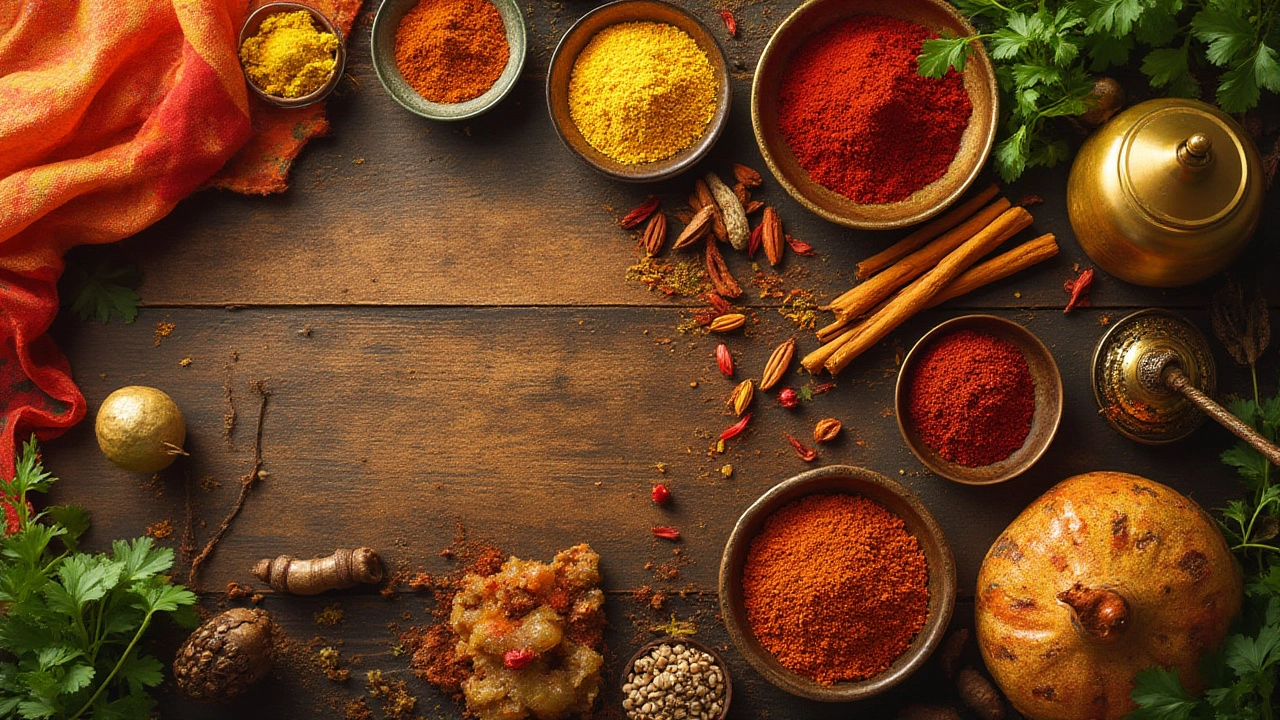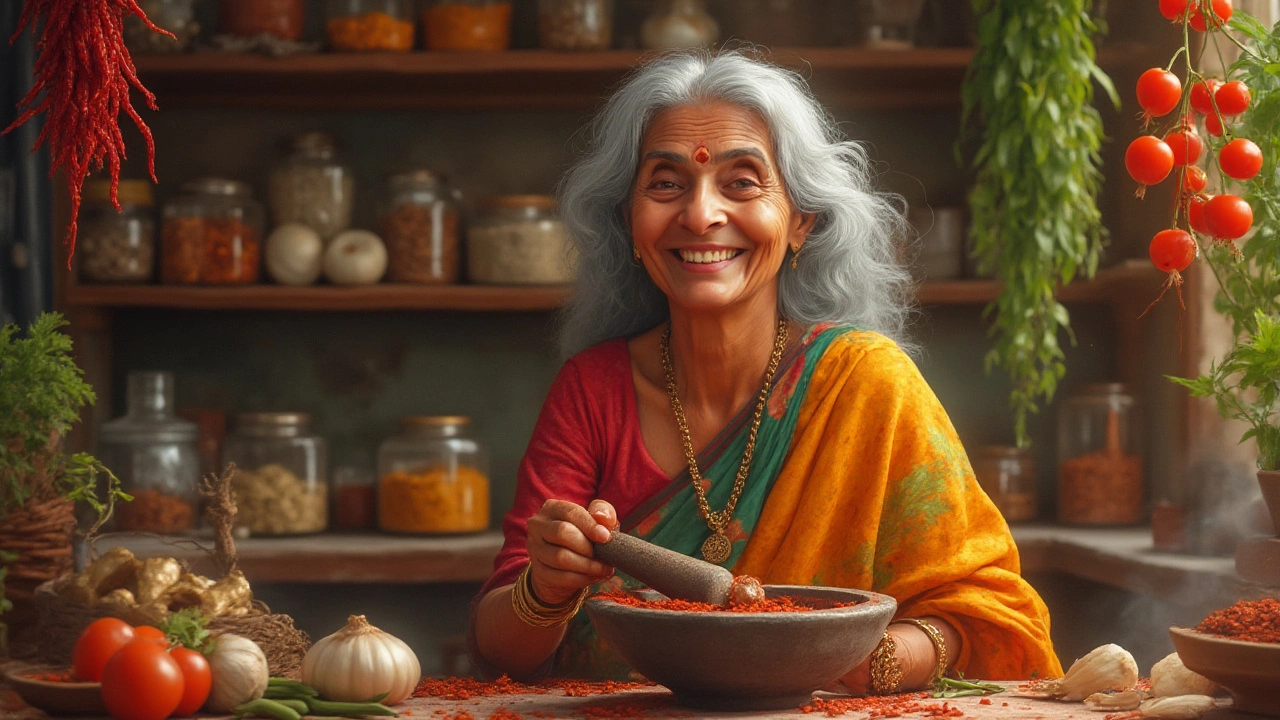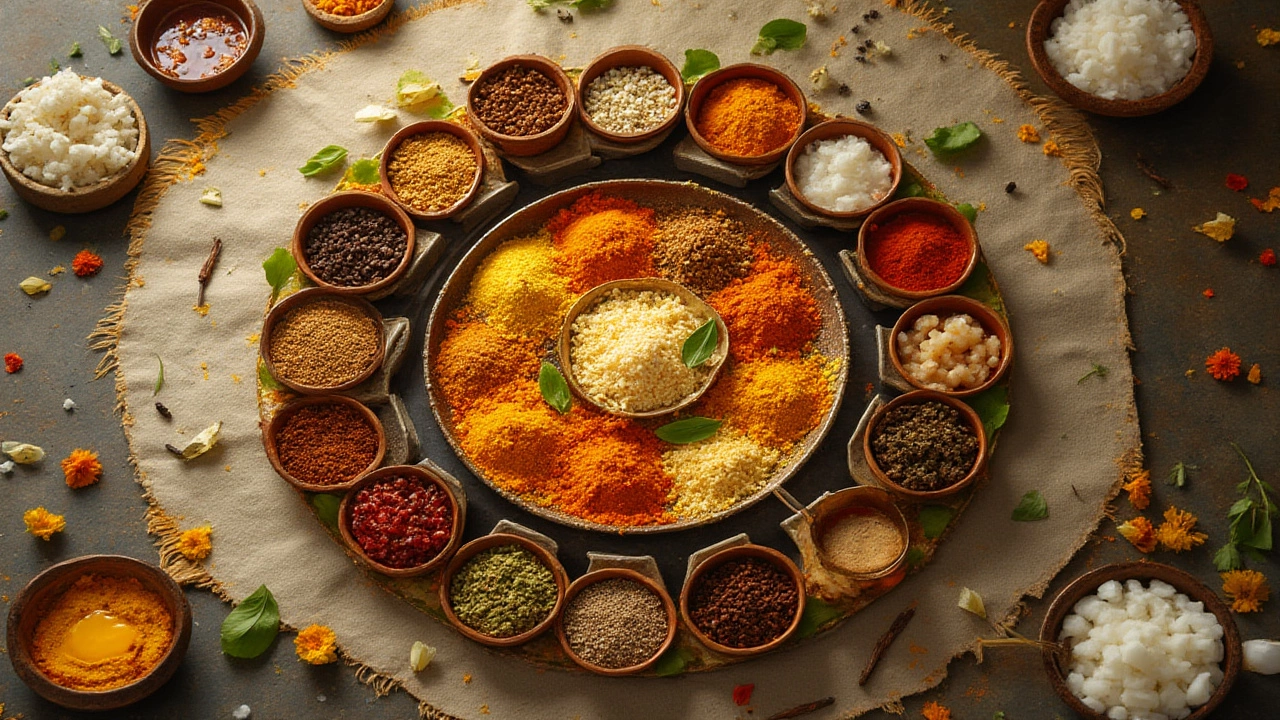Curry Ingredients: The Essential Flavors Every Dish Needs
 Jul, 22 2025
Jul, 22 2025
You won’t believe how many kitchen drawers are stuffed with mysterious spice packets, all thanks to the magic of curry. Curry dishes dazzle us with complex flavors that can be spicy, earthy, tangy, or even sweet. Yet beneath those layered tastes, there’s a core lineup of ingredients you’ll spot again and again in curries across India and beyond. For folks obsessed with flavor—and anyone standing confused in the grocery store aisle—a closer look at what actually goes into curry is long overdue.
The Essential Building Blocks: What Makes a Curry, a Curry?
Start rummaging through any curry recipe, and you’ll run into familiar faces—onion, garlic, and ginger. This trio forms the backbone for countless Indian dishes. Onions bring depth and a hint of sweetness, especially when cooked until golden brown. Ginger throws in that gentle heat and brightness, while garlic’s sharp bite fills the kitchen with comfort. Cook them together and you’ve got a base that’s fragrant before you even add anything else. If you skip this step or rush it, you’ll notice the curry is missing a dimension, somewhat like a song without its bass.
Turmeric is the next star player—it’s almost impossible to imagine curry without its golden hue. This root powder brings a warm, slightly earthy taste, plus an unmistakable color that makes your curry pop. A pinch or two is all you need for that classic look and subtle flavor. Don’t go overboard, though; too much can leave a bitter aftertaste.
Next, you’ve probably heard about cumin and coriander. These seeds, sometimes roasted first, are ground into powder or used whole. Cumin offers an earthy, nutty taste—think of the aroma when you crush roasted seeds between your fingers. Coriander, on the other hand, sneaks in lemony and floral notes. If fresh coriander leaves (known as cilantro) top your curry at the end, the flavor feels brighter, instantly fresher.
No talk of curry is complete without chilies. Depending on where you are—or your own heat tolerance—you’ll find everything from mild Kashmiri chili powder to explodingly spicy green birds-eye chilies. The choice sometimes depends on tradition or family tastes. If you’re new, start with less. Chilies bloom in hot oil, infusing your dish with warmth and color, but if you accidentally toss in a handful, prepare for a fiery surprise.
Tomatoes are another key ingredient for many modern curries. They add body, tang, and a little sweetness. Fresh tomatoes, pureed or diced, are common, but some cooks swear by canned tomatoes—especially during winter when fresh ones taste like cardboard. A splash of tomato helps balance rich or creamy curries, taming spice with a mellow acidity.
What about spices? Garam masala is the king of blends. Each family in India has its own mix, often kept secret for generations. The usual ingredients include cinnamon, cloves, cardamom, nutmeg, and black pepper. This fragrant mix is often added at the end of cooking to lock in the flavors. There’s no shame in buying pre-made garam masala, especially if you’re short on time, but if you ever get a chance to try a homemade blend, you’ll taste every warm, toasty note.
Oil or ghee (clarified butter) matters, too. Neutral oils like sunflower or canola are standard, but lots of cooks swear by mustard oil for its punch or coconut oil for South Indian curries. Ghee, with its nutty flavor and rich aroma, lifts the whole dish and delivers those beautiful crispy bits at the bottom of the pan (that’s called ‘bhuna’—don’t skip it!).
Salt, of course, brings everything together. Some cooks throw in a pinch of sugar or honey to balance acidity and heat—if you’ve never tried it, that tiny spoonful makes the spices sing without turning your curry sweet.

Signature Spices and Herbs: Beyond the Usual Suspects
Once you’ve nailed the basics, it’s time to play. Fennel seeds, with their licorice flavor, light up some Kashmiri curries. Fenugreek seeds or fresh fenugreek leaves (called ‘methi’) add a mellow sweetness with a bitter edge—think maple syrup but not quite. A few dried fenugreek leaves crumbled over butter chicken at the end? Trust me, it’s the secret weapon.
Mustard seeds pop and sizzle in the oil, giving southern curries their signature snap and nutty taste. Throw a pinch into hot oil and listen for the pop before you add onions and garlic, and you’ll get a sense of why this step matters. Curry leaves, mostly used in South Indian and Sri Lankan cooking, smell sharp, citrusy, and savory. Just a handful tossed at the start or end is enough. They pair beautifully with coconut milk and tamarind.
Tamarind brings bittersweet tang, perfect for curries that need a punch. It comes in paste or block form. Soak a chunk in water and squeeze out the juice, or cheat with ready-made paste. Use it in dishes like fish curry or sambar, where it balances creamy and spicy notes with its sharpness.
Cardamom pods—green or black—lend a sweet, floral aroma that’s almost intoxicating. Smash a pod or two, toss it into the pan, or grind some seeds for an added layer of decadence. Cloves and cinnamon bring warmth—picture the comfort of a spiced chai, now inside your curry. Both go especially well with lamb or chicken curries, deepening the flavors.
Coconut makes a regular appearance, especially in South Indian and Thai curries. Freshly grated coconut, coconut milk, or coconut cream cools the heat and adds silkiness. It’s slightly sweet, but more importantly, it’s soothing. When coconut and curry leaves meet in the same dish, the taste is instantly recognizable—think Kerala or Tamil Nadu specialties.
Yogurt is another surprise; it’s stirred in for creaminess in North Indian dishes like chicken tikka masala or kadhi. Some squeeze in a wedge of lemon or stir in dried mango powder (amchur) for sharp acidity. Every ingredient—from toasted sesame to roasted peanuts—serves a purpose, bringing harmony to the plate.
Saffron might not be in every curry, but in festive or royal dishes like biryani or Kashmiri rogan josh, a few strands tint the sauce golden, offering a subtle aroma that’s hard to describe unless you’ve tasted it. If you’re cooking on a budget, you can skip saffron, but its presence turns a regular meal into a celebration.
Not all curries are created equal, though. Thai curries load up on lemongrass, galangal, kaffir lime leaves, and Thai basil—different ingredients, but the same idea: building complex layers from simple parts. Malaysian and Caribbean curries, on the other hand, often add allspice, bay leaves, or star anise, showing how trade routes and migrations transformed a humble rice-and-sauce meal into a global icon.
This mix-and-match approach means curry is endlessly playful. Change one spice, swap coriander for fennel, bump up the mustard seeds, and suddenly you’re tasting something fresh and new. It’s no wonder that entire cookbooks, even culinary careers, are built on experimenting with curry flavor profiles.

Tips and Fun Facts: Making the Most of Curry Ingredients
Did you know that the word ‘curry’ isn’t Indian at all? It likely came from the Tamil word ‘kari,’ meaning sauce. Yet, it became shorthand in English for nearly every spicy, saucy dish coming from India, Pakistan, Sri Lanka, or Bangladesh—and even distant lands like the Caribbean or Japan. Each culture picked its favorite ingredients and techniques, so no two curries taste the same, even when they share the same core lineup.
Here’s a tip that home cooks overlook: the timing of adding spices makes a difference. Whole seeds (like cumin or mustard) go into hot fat at the start to bring out their oils. Powders work better after onions have softened, so they don’t scorch. Garam masala or delicate herbs should go in near the end to capture their aroma—if they cook too long, they fade into the background.
If you want that restaurant-style curry, pay attention to sautéing. Cook the onions until they’re a deep golden brown—don’t rush this step. The transformation is called ‘caramelization,’ and it’s where richness starts. Deglaze the pan with a little water or tomato, scraping up those brown bits.
Storage matters. Spices lose potency quickly when exposed to air and light. Whole spices keep longer than ground powders. Buy small quantities, and keep them in airtight containers, away from heat. If you have leftovers, grind your own spice blends. You’ll notice the difference.
Don’t feel pressured to use every ingredient—some of the best curries use fewer than five spices. It’s better to get to know what each spice adds, rather than tossing in the whole pantry and ending up with mystery mush.
Another little trick: a dash of cream or butter smoothed in at the end brings everything together. But for vegan curries, coconut cream works magic. You can even blend soaked cashews with a bit of water to make a rich, creamy sauce that’s dairy-free and deliciously satisfying.
People often ask about substitutes. Out of fresh ginger? Try ground, but reduce the quantity. Can’t handle heat? Skip the chilies and bump up the black pepper. No garam masala? Toast whole spices, then crush them for a quick homemade blend. Experiment—it’s harder to ‘ruin’ a curry than you think. Just taste as you go, and make little adjustments.
Let’s smash a myth: curries aren’t supposed to be hot. Some traditional dishes are mild and aromatic, loaded with spices but not fire. Others, like vindaloo or phaal, will make even chili lovers break a sweat. The heat level often depends on geography—you’ll find spicier curries in India’s south and west, mellower ones in the north and east. Always taste before adding extra heat.
Here’s a fun challenge: compare regional styles. Make a creamy North Indian curry full of dairy, garam masala, and tomato, then try a coconutty Goan curry with fresh curry leaves and tamarind. You’ll see how the same core building blocks (onion, ginger, garlic, cumin, coriander, and turmeric) can taste totally different just by playing with the supporting cast.
If you ever get the urge to make your own curry powder, go for it! Toast whole cumin, coriander, fenugreek, mustard seeds, and cinnamon sticks, cool them, then grind them up. Add turmeric and chili powder, and you’ve just built your own signature blend.
The most important thing to remember? The most common curry ingredients aren’t just for tradition—they’re for flavor. Every onion, sprinkle of cumin, or dash of curry ingredients brings harmony to the dish. Once you get the hang of these basics, making curry becomes more about rhythm than recipe—so trust your senses, experiment a little, and watch as your kitchen fills with warmth, conversation, and those beautiful, honest flavors.